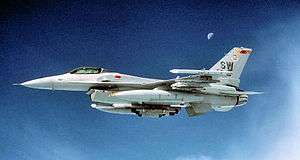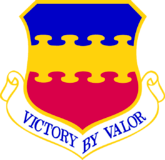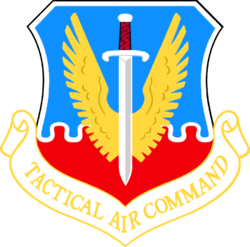20th Fighter Wing
| 20th Fighter Wing | |
|---|---|
 78th Fighter Squadron F-16C Block 50P 92-3920 | |
| Active | 1947–1948; 1948–present |
| Country |
|
| Branch |
|
| Role | Fighter |
| Part of | Air Combat Command |
| Garrison/HQ | Shaw Air Force Base, South Carolina |
| Motto(s) | Victory by Valor[1] |
| Engagements | 1991 Gulf War[1] |
| Decorations | Air Force Outstanding Unit Award[1] |
| Commanders | |
| Current commander | Colonel Derek J. O'Malley[2] (As of June 2018) |
| Notable commanders | Merrill McPeak[1] |
| Insignia | |
| 20th Fighter Wing emblem (approved 31 October 1951)[1] |
 |
The 20th Fighter Wing (20 FW) is a wing of the United States Air Force and the host unit at Shaw Air Force Base South Carolina. The wing is assigned to Air Combat Command's Ninth Air Force.
The wing's mission is to provide, project and sustain combat-ready aircraft in conventional and anti-radiation suppression of enemy air defenses, strategic attack, counter-air, air interdiction, joint maritime operations and combat search-and-rescue missions.
History

The 20th Fighter Wing was established on 20 July 1947 at Shaw Field, South Carolina and activated on 15 August. Upon its activation, the 20th commanded the functions of both the support groups as well as the flying 20th Fighter Group and the squadrons assigned to it. On 26 August 1948, the wing’s 20th Airdrome Group was discontinued and its elements became realigned under the 20th Air Base Group.
On 15 December 1993, the flight line at RAF Upper Heyford was closed. The wing moved without personnel and equipment from the UK to South Carolina on 1 January 1994, inheriting the personnel and equipment of the 363d Fighter Wing.
Two F-16s from the wing collided during a training flight on 15 October 2009. One F-16, piloted by Captain Lee Bryant, was able to land safely at Shaw.[3] The other plane, piloted by Captain Nicholas Giglio, 32, apparently crashed into the ocean. Authorities believe that Giglio was killed instantly in the collision and did not eject.[4] An accident investigation board determined that the crash was caused by pilot error. The board stated that Giglio was flying too fast and was not paying adequate attention as he attempted to rejoin Bryant's aircraft for the return flight to Shaw.[5]
Units
The 20th Fighter Wing is composed of four groups each with specific functions. The Operations Group controls all flying and airfield operations. The Maintenance Group performs maintenance of aircraft, ground equipment and aircraft components. The Mission Support Group has a wide range of responsibilities,a few of its functions are Security, Civil Engineering, Communications, Personnel Management, Logistics, Services and Contracting support. While the Medical Group provides medical and dental care.
- 55th Fighter Squadron
- 77th Fighter Squadron
- 79th Fighter Squadron
- 20th Operations Support Squadron
- 20th Maintenance Group
- 20th Aircraft Maintenance Squadron
- 20th Component Maintenance Squadron
- 20th Equipment Maintenance Squadron
- 20th Maintenance Operations Squadron
- 20th Mission Support Group
- 20th Communications Squadron
- 20th Contracting Squadron
- 20th Security Forces Squadron
- 20th Force Support Squadron
- 20th Logistics Readiness Squadron
- 20th Civil Engineering Squadron (20 CES)
- 20th Medical Group
- 20th Medical Operations Squadron
- 20th Aeromedical Squadron
- 20th Dental Squadron
- 20th Medical Support Squadron
Additionally, the 20th Comptroller Squadron reports directly to the wing commander.
Lineage
- Established as the 20 Fighter Wing on 28 July 1947
Assignments
|
|
Flying components
Group
- 20th Fighter Group (later 20 Fighter-Bomber Group, 20 Operations Group): 15 August 1947 – 26 August 1948, 14 August 1948 – 8 February 1955; 31 March 1992 – 1 January 1994; 1 January 1994 – present (detached 26 July-c. 17 December 1950 and 25 April – 10 October 1951)[1]
- 20th Maint, Mission Support Groups etc
Squadrons
- 42d Electronic Combat Squadron: assigned 1 July 1983 – 1 June 1985, attached 2 June 1985 – 24 January 1991, assigned 25 January 1991 – 1 July 1992.
- 55th Fighter-Bomber Squadron (later 55th Tactical Fighter Squadron, 55th Fighter Squadron): attached 15 November 1952 – 7 February 1955, assigned 8 February 1955 – 31 March 1992
- 77th Fighter-Bomber Squadron (later 77th Tactical Fighter Squadron, 77th Fighter Squadron): attached 15 November 1952 – 7 February 1955, assigned 8 February 1955 – 31 March 1992
- 79th Fighter-Bomber Squadron (later 79th Tactical Fighter Squadron, 79th Fighter Squadron): attached 15 November 1952 – 7 February 1955, assigned 8 February 1955 – 31 March 1992[1]
Stations
- Shaw Field (later Shaw Air Force Base), South Carolina, 15 August 1947 – 26 August 1948, 24 August 1948 – 9 November 1951
- Langley Air Force Base, Virginia, 9 November 1951 – 22 May 1952
- RAF Wethersfield, England, 31 May 1952 – 1 April 1970
- RAF Woodbridge, England, 1 October 1954 – 1 April 1970 (79th only)
- RAF Upper Heyford, England, 1 April 1970 – 1 January 1994
- Shaw Air Force Base, South Carolina, 1 January 1994 – present[1]
Aircraft operated
- Republic F-84G Thunderjet (1948–1955)
- Republic F-84F Thunderstreak (1955–1957)
- North American F-100D Super Sabre (1957–1971)
- General Dynamics F-111 Aardvark (1970–1993)
- General Dynamics–Grumman EF-111A Raven (1984–1992)
- General Dynamics F-16 Fighting Falcon, 1994 – present[1]
References
- Notes
- ↑ Aircraft is North American P-51D-30-NA Mustang serial 44-74558 at Shaw Field. Note the postwar buzz number on the fuselage, and "20th Fighter Group" written on the tail cap.
- ↑ The experimental Table of Distribution 20th Fighter Wing was discontinued on this date. Ravenstein, p. 38.
- ↑ The permanent Table of Organization 20th Fighter Wing was activated on this date. Ravenstein, p. 38. The two wings were consolidated on 1 October 1984.
- Citations
- 1 2 3 4 5 6 7 8 9 10 11 Robertson, Patsy (February 13, 2008). "Factsheet 20 Fighter Wing (ACC)". Air Force Historical Research Agency. Retrieved May 12, 2017.
- ↑ "Biographies". Shaw Air Force Base. Retrieved 22 September 2018.
- ↑ Washington Post, "Plane Search Expands; Debris Seen In Atlantic", 17 October 2009.
- ↑ Collins, Jeffrey, "Missing F-16 pilot had no chance to eject", Military Times, 18 October 2009.
- ↑ Rolfsen, Bruce, "Report: Pilot error caused F-16s to collide", Military Times, 11 January 2010.
Bibliography
![]()
- This article includes content from Shaw AFB Website's history page.
- Martin, Patrick (1994). Tail Code: The Complete History of USAF Tactical Aircraft Tail Code Markings. Atglen, PA: Schiffer Military Aviation History. ISBN 0-88740-513-4.
- Maurer, Maurer, ed. (1983) [1961]. Air Force Combat Units of World War II (PDF) (reprint ed.). Washington, DC: Office of Air Force History. ISBN 0-912799-02-1. LCCN 61060979. Retrieved December 17, 2016.
- Maurer, Maurer, ed. (1982) [1969]. Combat Squadrons of the Air Force, World War II (PDF) (reprint ed.). Washington, DC: Office of Air Force History. ISBN 0-405-12194-6. LCCN 70605402. OCLC 72556. Retrieved December 17, 2016.
- Mueller, Robert (1989). Air Force Bases, Vol. I, Active Air Force Bases Within the United States of America on 17 September 1982 (PDF). Washington, DC: Office of Air Force History. ISBN 0-912799-53-6. Retrieved December 17, 2016. * Ravenstein, Charles A. (1984). Air Force Combat Wings, Lineage & Honors Histories 1947-1977 (PDF). Washington, DC: Office of Air Force History. ISBN 0-912799-12-9. Retrieved December 17, 2016.
- Rogers, Brian. (2005). United States Air Force Unit Designations Since 1978. Hinkley, UK: Midland Publications. ISBN 1-85780-197-0.
- USAAS-USAAC-USAAF-USAF Aircraft Serial Numbers—1908 to present
- Shaw AFB Home Page


